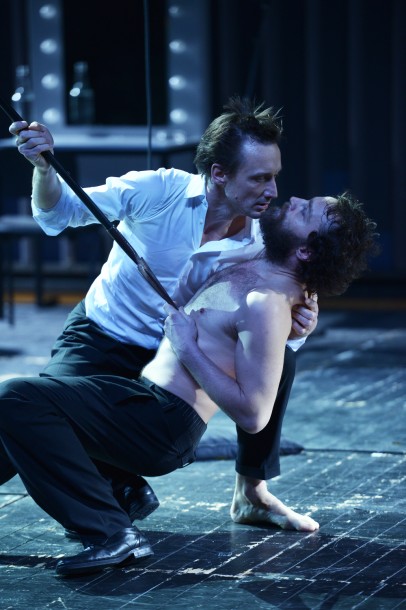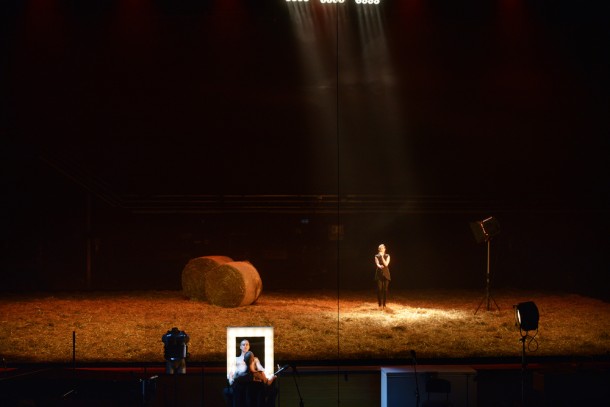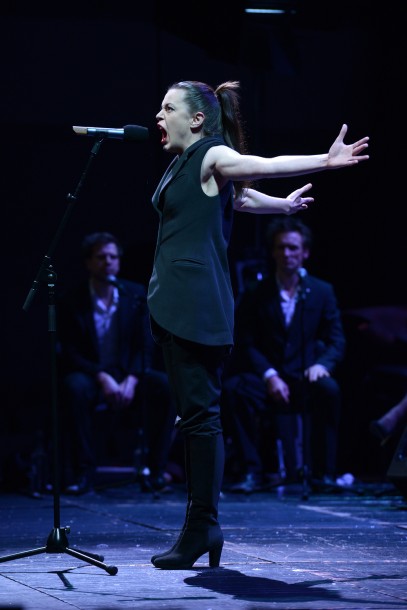In the beginning was the Word.
In the beginning was—The Iliad.
These words can best sum up both the story and the scenic language of the remarkable performance Ilijada (The Iliad), a co-production of three important cultural institutions in Ljubljana (Slovenia): Slovensko narodno gledališče (Slovene National Theatre), Mestno gledališče (Ljubljana City Theatre), and Cankarjev Dom (Cankar Hall). At the 49th Bitef (Belgrade International Theatre Festival), where I saw it in September of 2015, it was received overwhelmingly by both the audience and international critics.
Jernej Lorenci, one of the leading Slovene theatre directors and his dramaturgs Eva Makhović and Matić Starina have not adapted Homer’s epic poem into a dramatic form, but have chosen a seemingly simpler and self-evident solution: to put the epic into the form of storytelling. Dressed in contemporary smart evening suits and dresses, the actors are seated in a circle, around the stage, surrounded by musical instruments such as a piano and a harp (stage design by Branko Hojnik) and they only get to their feet when they are to step onto the forestage, stand in front of a fixed microphone and speak their lines: “In the beginning was the Word.”

The Iliad by Homer, directed by Jernej Lorenci at SNG Drama Ljubljana. Photo credit: Peter Uhan.
Regarding the costumes, it must be noted that they reflect a principle of cultural polyphony that is a distinctive characteristic of the entire performance. The costumes are neither stylistically nor historically as uniform as they seem at first; rather, they possess a certain deconstructive différance, a quality that deviates from the epoch or dressing conventions. Some actors wear suit jackets on their naked bodies, without a shirt; one actress is in an antique dress, another in a mid-twentieth-century gown, while yet another is dressed in eclectic Balkan folklore clothes (costume design by Belinda Radulović). Thus, on the very visual level, the costumes discreetly indicate that the performance is not an actualization of the antique epic poem; indeed, it intertwines different epochs and cultures.
The static mise-en-scène, the actors remaining seated in front of the audience when not taking part in the current scene, speaking into a microphone, the predominantly contemporary and black-and-white costumes—all of these can appear as a cliché of a stylized, cold, hermetical, cerebral theatre. This impression, however, is shattered by the core expressive mode of the performance: speech. Actors speak facing the audience, usually without interacting with one other, standing statically in front of the microphone, but their speech is by no means cold and alienated; quite the contrary, it is vehement, emotional, electrifying. This internal charge is further enhanced by a directorial intervention: while the actors are sitting and listening to the actor who is standing and speaking, they are tapping on the microphones placed next to their chairs. In this way, the stage speech is punctuated by an intensive rhythmic accompaniment, emphasizing the original rhythmicity of Homer’s verse. Besides this formal function, the “choral” microphone tapping creates an exciting impression of ritual ambience, ancient time, primal instincts, even the basic biological rhythm: the heartbeat. Not unlike the costumes, this “ritual rhythm” prompts associations not of antiquity or any other ancient civilization, but has a somewhat generic effect.
Besides the emphatic, microphone-tapped rhythm, the performance features other significant musical elements. The most obvious are the musical parts, both instrumental and vocal, in the scenes in which the actors sing. Music genres are extremely diverse, eclectic, and range from classical harp compositions, through popular mid-twentieth-century music and jazz, to folk songs performed on the traditional instrument of gusle (composer Branko Rožman). Thus music serves as another layer interweaving various epochs and civilizations, undercutting the the possibility of situating the action in any single timeframe. The third musical element is the most abstract and yet the most significant of all: Lorenci develops the stage composition according to musical principles, with acceleration, creation of a polyphonic effect, crescendo and, ultimately, with a slow, serious, but somehow soothing tempos of lento and adagio. The entire performance, actually, is reminiscent of an oratory.
Even though the tempo changes gradually, there is one crucial turning point. Consisting of two parts, the performance picks up in tempo in the latter. This matches the rise of tension in the story itself. Namely, the second part—accompanied by the music of gusle and atavistic cries—speaks of the Trojan War, depicting battles between the Greek and Trojan heroes. Now, these scenes are less static and their form is not only auditory, but there is a visual element added: each duel is rendered as an image. Besides achieving a strong visual effect, these scenes serve a powerful signifying function. In several duel scenes, the victim, who is tortured and eventually killed—although in a stylized, choreographed manner—is always the same, unknown, half-naked man (played by the production’s choreographer Gregor Luštek). This can be seen as an indication that in wars waged by gods and heroes they are not the ones who are the victims, it is instead the common, unknown, unprotected (naked) people that are the true casualties.
In addition to the visual effects, the duel scenes are marked by an emphasis on corporal expressivity. The actors’ performance is no longer static, but, on the contrary, energetic, expressive, physical. The bodies engaged in combat are male; they are often half-naked and under extreme physical strain, all of which creates a discreet, yet homoerotic experience nevertheless. There is, for instance, the subtly eroticized scene in which Achilles (Jure Henigman) is mourning the dead Patroclus (Blaž Setnikar). Although these scenes can be seen as a cliché—war as a macho, macho-war-turn-bacchanalia–this gendered moment can, by no means, be neglected in the interpretation of Lorenci’s performance. Earlier scenes to support this reading, such as the one in which Zeus (Matej Puc) sexually abuses Hera (Jete Ostan Vejrup), but can neither humiliate nor subjugate her: he is very crude and stupid, while she remains, despite the circumstances, ironic and superior. Neither is it the case that the other female characters are represented as stereotypes. The archetype of femininity, Helena (Tina Potočnik), does not appear to be a victim of male abuse as she, utterly self-consciously, decides to get undressed in front of the men in one scene, and then—similarly to Hera—she appears superior to them. Unobtrusive as it is, the feminist layer of this performance is absolutely unquestionable: war is the domain of men.

The Iliad by Homer, directed by Jernej Lorenci at SNG Drama Ljubljana. Photo credit: Peter Uhan.
However, the meanings of the performance are not exhausted here. It arrives, quite logically, to its final point in the last scene, effective not only on the cognitive level but, first and foremost, on the emotional one. Actually, it is one of the most exciting, poetic, and touching theatre finales that I have ever seen. When the war carnage is over, after the aforementioned crescendo of the various music genres, atavistic cries, bulging muscles and sweating bodies—it is then, when everything subsides, that the adagio washes over. The actors now exist on the stage almost as private persons, some have lain on it as if to rest, and the harpist starts playing a gentle melody. While playing, she speaks tenderly to individual actors, addressing them by their real names, and then repeats the following leitmotif in English: “Janez [one of the actors] is going to die. We are all going to die.” At a certain moment she turns to the audience; her eyes focus on one of the spectators; she asks his or her name and repeats her refrain, this time using the name given.
If we accept the position of Erika Fischer-Lichte that the analysis of a performance should simultaneously be approached from both a semiotic and phenomenological point of view, since the events on the stage constantly oscillate between the corporal, energetic, and sensual phenomena (the subject of phenomenological method) and the sign that refers to the outside world (the subject of semiotic method), then it is clear that it is the phenomenological approach that is first mobilized in the analysis of this scene. The vehement energy and excitement felt in this scene come as a result of its emotional effect: a gentle, soothing call of the harp and female voice to relax, surrender, and set off to the other world.
Moving from a sensual and emotional experience to the interpretative level, all that we get are utterly free associations: the scene with the harp and the refrain “we are all going to die” can be understood in quite different ways, and my reading of it here is necessarily subjective as well. The “we” obviously refers to a plural of individual cases—the concrete actors and spectators that the harpist addressed by their names—and as such it marks the anthropological core of our lives: the fact that they are transitory. But, this “we” can also refer to a community, society. Which community might that be? Analyzing the costumes and music, I showed that they are purposefully eclectic, creating an effect I described as cultural polyphony, and that the context of this Iliad cannot be pinpointed with certainty. Therefore, at the end of this text, we must go back to its beginning.

The Iliad by Homer, directed by Jernej Lorenci at SNG Drama Ljubljana. Photo credit: Peter Uhan.
In the beginning was the word, because The Iliad is an epic poem, and because in this performance it is not adapted into a dramatic form, but is still narrated. In the beginning was The Iliad as well, since it is the oldest, formative epic of Western civilization. If we assume this position, then the phrase “we are all going to die” can be understood as an announcement of the end of our civilization as such. Birth is the first step towards death, a beginning is always an announcement of an end; similarly, the epic that gives birth to a civilization is at the same time its requiem. Surely, it would be an exaggeration to take this staging of The Iliad as the requiem for Western civilization, but it can certainly be understood as a warning. Theatre is the most social of all arts, so the analysis of a performance unavoidably depends on the context in which it is seen. I saw The Iliad in Belgrade, just a two-hour drive from the Serbian-Hungarian border where, only several weeks earlier, a wire fence was erected to prevent the refugees from the Middle East from entering the European Union. Twenty-five years after the fall of the Berlin Wall, new walls are being raised in the very heart of Europe; refugees are fleeing the Middle East ravaged by wars; entire cities are disappearing, both modern and ancient, the ones whose traces survived for centuries; people are drowning in the Mediterranean; its shores, at the very spot where mythical Troy used to be, are washed with dead bodies of innocent children. In such a world, this staging of The Iliad truly seems a warning to the civilization to which this epic poem gave birth.
was born in Belgrade, Serbia. He simultaneously studied Philosophy and Dramaturgy. Medenica holds the title of associated professor teaching The History of World Drama and Theatre at the Faculty of Dramatic Arts and he is, at the same time, the Chief of the Department of Theory and History at FDA. He regularly publishes articles in the national and foreign theatre periodicals; his articles have been published in French, English, German, Czech, Hungarian, Spanish, Polish, Slovakian, and Romanian among others. He is actively engaged in theatre criticism and has received the annual National Award for the Best Theatre Criticism five times. From 2003-07 Medenica was the Artistic Director of the Sterijino pozorje theater festival in Novi Sad. From 2002-12 he was an editor in the main Serbian theater journal Teatron. From 2011-13, Medenica was a fellow in the International Research Center The Interweaving performance cultures (FU, Berlin). Since 2007, he has served as the Adjunct Secretary General of the IATC.
European Stages, vol. 6, no. 1 (Spring 2016)
Editorial Board:
Marvin Carlson, Senior Editor, Founder
Krystyna Illakowicz, Co-Editor
Dominika Laster, Co-Editor
Kalina Stefanova, Co-Editor
Editorial Staff:
Elyse Singer, Managing Editor
Clio Unger, Editorial Assistant
Advisory Board:
Joshua Abrams
Christopher Balme
Maria Delgado
Allen Kuharsky
Bryce Lease
Jennifer Parker-Starbuck
Magda Romańska
Laurence Senelick
Daniele Vianello
Phyllis Zatlin
Table of Contents:
- Hamlet in a Curious Nutshell by Maria Helena Serôdio
- Alvis Hermanis Productions in Latvia and German-Speaking Countries by Edīte Tisheizere
- The Unknown, the Unexpected, and the Uncanny: A New Lorca, Three New Catalan Productions, and a Few Extras by Maria M. Delgado
- 2015 Dance Week Festival and Contemporary Croatian Dance by Mirna Zagar
- Archives, Classics, and Auras: The 2016 Oslo International Festival by Andrew Friedman
- The Stakes for City Theatres: Linus Tunström’s Farewell to the Uppsala Stadsteater by Bryce Lease
- Life is Beautiful? or Optimistically About Bulgarian Theatre? by Kalina Stefanova
- The Multiple Dimensions of the Bulgarian ACT Independent Theatre Festival 2015 by Angelina Georieva
- Theatre in Berlin, Winter 2015 by Steve Earnest
- Musical Theatre in Berlin, Winter 2015 by Steve Earnest
- Gob Squad’s My Square Lady at the Komische Oper by Clio Unger
- New Productions in Berlin by Yvonne Shafer
- Manifest for Dialogue: Antisocial by Ion M. Tomuș
- A Fall in France by Heather Jeanne Denyer
- The Iliad as an Oratory: A Warning to a Civilization by Ivan Medenica
- Escaped Alone by Caryl Churchill at the Royal Court Theatre by Rosemary Malague
- Bakkhai at the Almeida Theatre reviewed by Neil Forsyth
Martin E. Segal Theatre Center:
Frank Hentschker, Executive Director
Marvin Carlson, Director of Publications
Rebecca Sheahan, Managing Director
©2016 by Martin E. Segal Theatre Center
The Graduate Center CUNY Graduate Center
365 Fifth Avenue
New York NY 10016



